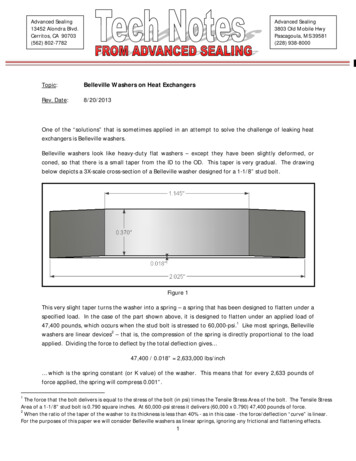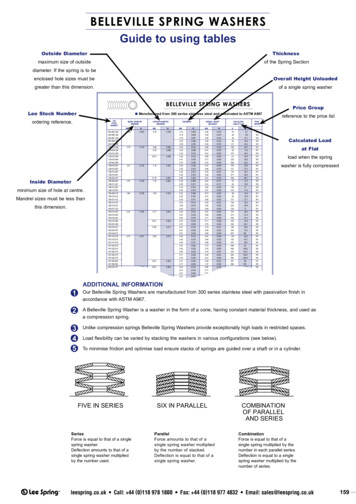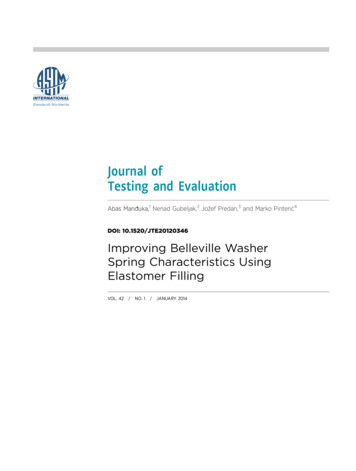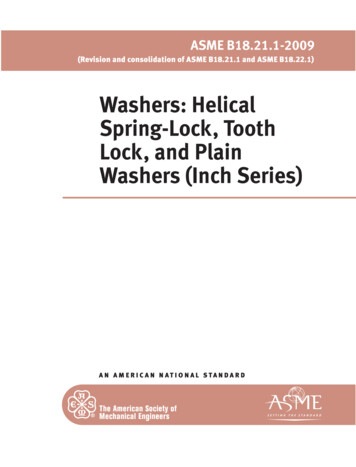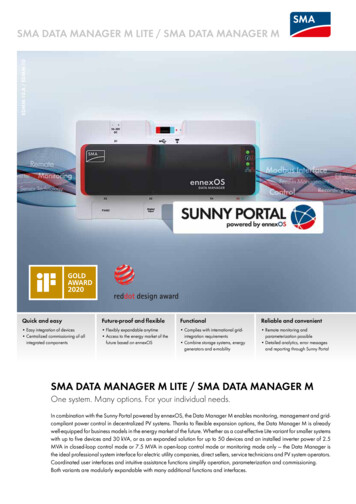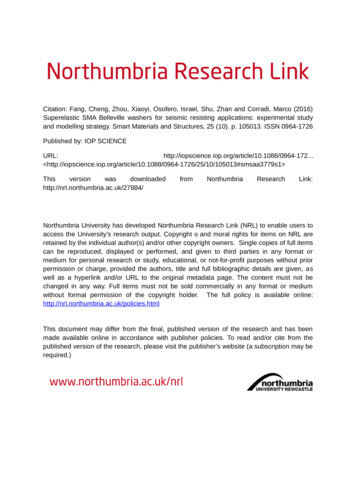
Transcription
Citation: Fang, Cheng, Zhou, Xiaoyi, Osofero, Israel, Shu, Zhan and Corradi, Marco (2016)Superelastic SMA Belleville washers for seismic resisting applications: experimental studyand modelling strategy. Smart Materials and Structures, 25 (10). p. 105013. ISSN 0964-1726Published by: IOP 88/0964-172. 6/25/10/105013#smsaa3779s1 uk/27884/fromNorthumbriaResearchLink:Northumbria University has developed Northumbria Research Link (NRL) to enable users toaccess the University’s research output. Copyright and moral rights for items on NRL areretained by the individual author(s) and/or other copyright owners. Single copies of full itemscan be reproduced, displayed or performed, and given to third parties in any format ormedium for personal research or study, educational, or not-for-profit purposes without priorpermission or charge, provided the authors, title and full bibliographic details are given, aswell as a hyperlink and/or URL to the original metadata page. The content must not bechanged in any way. Full items must not be sold commercially in any format or mediumwithout formal permission of the copyright holder. The full policy is available his document may differ from the final, published version of the research and has beenmade available online in accordance with publisher policies. To read and/or cite from thepublished version of the research, please visit the publisher’s website (a subscription may berequired.)
Superelastic SMA Belleville washers for seismic resistingapplications: experimental study and modelling strategyCheng Fanga), Xiaoyi Zhoub)*, Adelaja Israel Osoferoc), Zhan Shua), Marco Corradid)a)Department of Structural Engineering, School of Civil Engineering, Tongji University, Shanghai 200092, Chinab)School of Civil Engineering & Geosciences, University of Newcastle, Newcastle upon Tyne, NE1 7RU, UKc)School of Engineering, University of Aberdeen, Aberdeen, AB24 3FX, UKd)Department of Mechanical & Construction Engineering, Northumbria University, Wynne-Jones Building, Newcastleupon Tyne NE1 8ST, UK* Corresponding author: email: xiaoyi.zhou@ncl.ac.uk, Tel: 44 (0) 191 208 7924Abstract: This study sheds considerable light on the potential of superelastic Shape Memory Alloy(SMA) Belleville washers for innovative seismic resisting applications. A series of experimentalstudies were conducted on washers with different stack combinations under varying temperatures andloading scenarios. The washers showed satisfactory self-centring and energy dissipation capacities atroom temperature, although slight degradations of the hysteretic responses accompanied by residualdeformations were induced. The hysteretic loops became stable after a few number of cycles,indicating good repeatability. The washers also showed good flexibility in terms of load resistance anddeformation, which could be easily varied via changes in the stack combination. Compromised selfcentring responses were observed at temperatures below 0 C or above 40 C, and a numerical study,validated by the experimental results, was adopted to further investigate the deformation mechanismof the washers. A further phenomenological model, taking account of the degradation effects undervaried temperatures, was developed to enable effective and accurate simulation of devicesincorporating the washers. Good agreements were observed between the test and simulation results,and the model was shown to have good numerical robustness for wide engineering applications.Keywords: shape memory alloy (SMA); superelastic; Belleville washers; self-centring; numericalstudy; phenomenological model.1. IntroductionShape Memory Alloys (SMAs), as a class of smart materials, have been successfully employedin the aerospace (e.g. aircraft wings and smart helicopter blades) and medical (e.g. arterial stents andcatheters) industries [1-2]. SMA has two unique properties, namely, Superelastic Effect (SE) andShape Memory Effect (SME) [3]. When SMA is deformed above the austenitic finish temperature Af,it starts to accommodate the strain by transforming from the austenitic phase into the detwinnedmartensite phase. However, the deformation (up to 8-10% strain) can be recovered spontaneouslyafter unloading, i.e. the detwinned martensite will revert back to austenite. This phenomenon is knownas the Superelastic Effect (SE). On the other hand, when the SMA is deformed below the martensiticfinish temperature Mf, it is transformed from the twinned martensitic phase to the detwinnedmartensitic phase. Upon unloading, residual deformation remains, but heating the deformed SMA can1
promote strain recovery. This phenomenon is known as Shape Memory Effect (SME). Withcontinuous improvement in metallurgic technology and reduction in manufacturing cost, along withbetter understanding of the material property, the practical applications of SMA are nowadaysstretching beyond the existing high-value fields, where one of the new areas of application is civilengineering. Special interest is given to self-centring seismic control, where SE of SMA is widelyutilized in passive control, while SME is normally considered in active control or semi-active control[4]. Although both passive and active (semi-active) controls can be promising strategies againstseismic hazard, more attention has been paid to SE of SMA due to the inherent characteristics such asspontaneous self-centring, hysteretic damping, and free of external power source.Innovative devices and applications based on superelastic SMA have been explored by a largenumber of researchers. As wire is one of the most convenient forms of SMA due to its ease ofmanufacture and high utilisation efficiency, significant research efforts have been devoted to theapplication of SMA wires in base isolators [5-6], dampers [7-8], and bracing systems [9-11]. Whilegood self-centring abilities coupled with reasonable energy dissipation were generally observed inthese devices or structural components, a large number of wires need to be included to ensure that thelevels of load resisting capacity match the magnitude required for accommodating ‘structural-level’loading. This can complicate the arrangement of the wires and more importantly, complicate thegripping (end-fixing) strategy due to the difficulty of effective gripping over the smooth wire surface.As most of the existing research on SMA wire-based devices were either proof-of-concept (e.g.numerical and theoretical) or small-scale tests (where small diameter SMA wires were adopted), theefficiency of SMA wires for large-scale structural components/facilities should be further examined.Using stranded SMA ropes instead of smooth SMA wires may be an encouraging solution. Recentstudies [12-13] showed that the performance of stranded SMA ropes was dependent on the helix angle,and the energy dissipation capacity and self-centring ability were less satisfactory than single SMAwires. Moreover, the available studies mainly focused on the uniaxial cyclic performance of thestrands with no specific discussion on the gripping strategy. Larger diameter SMA bars can be anotheralternative to SMA wires in order to achieve a reasonable level of load resistance for structures. Theends of the SMA bars are often threaded such that they can be used as bolts for connections [14-17]and bridge restraining devices [18]. However, relevant test programmes [15-16] showed that SMAbolts were quite susceptible to fracture over the threaded area. Increasing the net threaded-to-shankarea ratio (which decreases the stress demand over the threaded area) may improve the ductility of theSMA bolts.To potentially address the above mentioned barriers to the use of SMA, a new form of SMAcomponent, namely, superelastic SMA Belleville washer, could be an important addition to the'arsenals' against seismic hazard. A Belleville washer [19], also known as conical spring washer or2
disc spring, is a mechanical component which can sustain a wide range of loads with small installationspace. Because of their annular shape, as shown in Fig. 1, force transmission is relatively even andconcentric and thus they can be more stable compared with other springs, e.g. helical springs. WhenBelleville washers are endowed with superelastic ability, which enables self-recovery and hystereticdamping, their application may be further expanded. Early studies on SMA Belleville washers weremainly for electrical applications with the main purpose of electric circuit stabilisation [20]. Thepotential of superelastic SMA Belleville washers as seismic resisting dampers was first investigatedby Speicher et al. [21]. The washers showed satisfactory self-centring ability, but the hystereticstabilisation properties with repeated cycles was not revealed as only a limited number of cycles wereperformed. It was also found that the load carrying capacity decreased significantly with increase indeformation beyond the peak load, and the resulting ‘invert’ tendency compromised the dampingperformance of the washer groups. It was argued that the snap-through behaviour was due to therelatively high cone angle (Fig. 1) considered for the test washers. A later numerical investigation[22] considered different geometric shapes of the washers, and the results showed that good selfcentring and energy dissipation responses could be achieved if the geometric configuration of thewashers is appropriately designed. More recently, Maletta et al. [23] introduced a newthermomechanical process for producing SMA Belleville washers through disk cutting and asuccessive shape setting by heat treatment. This was then followed by Finite Element (FE) studies onthe influences of washer geometric configuration and temperature on their cyclic performance, but nofurther experimental proof was provided. A semi-analytical model, which was found to correlate wellwith the FE predictions, was also developed [24]. Other types of SMA components, e.g. SMA rings[25-26], are also under development.Fig. 1 SMA Belleville washers and key dimensions (not-to-scale)It can be seen from the above discussion that the research on SMA Belleville washers forseismic engineering is quite promising but is still in its early stage, and in particular, their cyclic3
repeatability and temperature dependence have not been physically investigated. Information oneffective modelling of SMA Belleville washers is also insufficient. The present work, done incollaboration with MEMRY (SMA manufacturer), discusses the mechanical property and modellingstrategy of superelastic SMA Belleville washers for innovative seismic resisting applications. Thestudy will reveal the feasibility of commercializing SMA for the construction industry, and this willbenefit communities of both civil engineers and material scientists.2. Experimental programme2.1 Test specimensA total of 11 specimens, including ten NiTi SMA-based washer specimens and onecommercial stainless steel washer, were tested in this experimental programme. The main testparameters were temperature and arrangement of washers. The influence of maximum deformation(Smax) on the mechanical properties of the washers was also studied. The basic test parameters aregiven in Table 1. The same geometric configuration was chosen for all the SMA Belleville washers:the external diameter (De) and internal diameter (Di) were 45 mm and 20 mm, respectively; the overallheight (H) of the washer was 7 mm, and the thickness (t) was 4mm. The considered geometricconfiguration led to a cone angle ( ) of 13.5 . The key dimensions are illustrated in Fig. 1. The SMABelleville washers were produced by the material supplier MEMRY (www.memry.com). Perinformation from the supplier, the austenite finish temperature Af was 4.5 C such that the washers canexhibit superelastic behaviour at ambient temperatures (i.e. room temperature was approximately23 C for the current test). The composition of all the specimens was nearly identical, with 55.87%nickel – 44.13% titanium by weight. All the specimens were hot-rolled with an appropriate heattreatment by the material supplier, and they were tested in received condition with no further heattreatments. The stainless steel washer was purchased from a commercial washer supplier, and thedimension was slightly different to the SMA Belleville washers: De 50 mm, Di 22 mm, t 5 mm,and the allowable deformation 1 mm. The stainless steel washer test was a demonstration test forcomparison purpose only. All the specimens were virgin without pre-training before the tests.Table 1 Test parametersSpecimen codeSmax (40)SMA1-T(60)SMA1-T(0 23)SMA1-T(-20 23)2.72.71.35.42.72.72.72.72.72.7Temperature( C)23232323231040600 23-20 234ArrangementSingleSingleSingleTwo in seriesTwo in parallelSingleSingleSingleSingleSingle
SS11.023SingleThe specimens were tested isothermally under various temperatures ranging from -20 C to60 C. Single (individual) washer tests were conducted, and in addition, washer groups consisting oftwo washers stacked in two different ways, i.e. in series and in parallel (as illustrated in Fig. 1), werealso investigated. For easy identification, each specimen was assigned with a specimen codeaccording to its washer arrangement, temperature, and loading condition. The specimen code startswith the material type, i.e. SMA or SS (stainless steel), followed by 1 or 2 indicating the number ofwashers in the test specimen, and ends with a description of the test, where ‘a’ and ‘b’ means twoduplicate tests on single washer; ‘H’ means only half of Smax was applied; ‘S’ and ‘P’ indicate twowashers stacked in series and in parallel, respectively, and ‘T’ indicates that the test was conductedunder a temperature (which is shown after ‘T’) different from the room temperature (23 C). It shouldbe noted that for some specimens, e.g. specimen SMA1-T(-20 23), two temperatures were included inthe specimen code, this is because the test was first conducted under a temperature below Af and thenthe temperature was increased beyond Af (back to room temperature) for further testing. Details of thetest procedures are discussed in the following section.2.2 Test setup, procedures, and instrumentationsThe specimens were subjected to compressive cyclic load with a loading frequency of 0.02 Hzunder displacement control. The standard maximum displacement Smax of each cycle was 2.7 mm,such that the washer could be deformed to an almost flattened state at Smax. For specimen SMA1-H,Smax 1.3 mm was considered in order to examine the performance of the washer when only a half ofthe allowable deformation is utilized. For specimen SMA2-S, where two washers were stacked inseries, the maximum displacement was doubled (i.e. 5.4 mm). A single stainless steel washer was alsotested and the arrangement of this test was basically the same but with 1 mm maximum deformation.For the specimen tested under the temperature above Af, the loading-unloading process was repeatedfor 50 cycles to monitor the degradation response of the hysteretic curve. For those tested below Af,where the superplastic behaviour could not be fully developed, 10 cycles were carried out first, andthen the temperature was increased and additional 50 loading cycles were performed at roomtemperature. These stepped-temperature tests were used to investigate the influence of lowtemperature weather conditions as well as the ability of the washers to regain superplastic behaviourwith reheating. Before each test (or test stage), the specimen was placed under the requiredtemperature for at least 30 minutes to ensure an even distribution of the internal temperature withinthe washer.5
Fig. 2 Photo and details of test setupThe cyclic tests were performed using an INSTRON 5585H Universal Test Machine (UTM)with a maximum loading capacity of 250 kN. The aforementioned loading protocol was implementedand the experimental data (load and displacement) were automatically recorded via built-in load celland displacement controllers. For the specimens exposed to temperatures other than the roomtemperature, an environmental chamber was employed which is capable of offering a constanttemperature ranging between -70 C and 350 C. A bespoke testing device, as shown in Fig. 2, wasdesigned for holding the washers in position throughout the experiment. The device consisted of twocylinders, with the top cylinder fixed to the loading head of the UTM and the bottom one fixed to thebase of the machine. The washers were passed through a rod fixed at the surface of the bottomcylinder, and correspondingly a hole was made in the top cylinder to accommodate the rod during thetest. By using this piston-type device, the compressive load can be applied uniformly onto the washersand the conditions (e.g. deformed shape) of the washers can be clearly observed during the test. Forspecimen SMA2-S, where two washers were stacked in series, an additional steel plate was placedbetween the two washers. Detailed dimensions of the testing device are shown in Fig. 2.3. Test results and discussions3.1 Load-deformation responseThe load-deformation curves of all the specimens are shown in Fig. 3. For the SMA Bellevillewashers tested under temperatures above Af (4.5 C), flag shape hysteretic curves with recognizableforward and reverse transformation plateaus are typically exhibited. The load (of single washer) atmaximum deformation ranged between 10 kN and 17.5 kN, and the value tended to increase withincreasing temperature. This is due to the well-known austenite and martensite slopes (of phase6
diagrams) where the forward/reverse transformation plateaus increase almost linearly with increasingtemperature [3], as illustrated in Fig. 4. Considering the maximum compressive deformation of 2.7mm, the secant stiffness of single washers varied approximately between 3.7 kN/mm and 6.5 kN/mm.Degradations of the hysteretic responses, accompanied by residual deformations, were induced,especially in the first few cycles; however, the hysteretic loops then became stable with increasingnumber of cycles. The degradation response was mainly due to the Transformation Induced Fatigue(TIF) in SMA, where the significance of TIF depends on various factors, including fabrication process,heat treatment, temperature, loading conditions, etc. [3].Fig. 3 Load-deformation response of test specimens7
Fig. 4 Phase diagram of superelastic SMAVery minor ‘snap-through’ type load-deformation response (duck-head-shaped curve) wasobserved in some specimens in their first cycle, but this response quickly disappeared in the followingcycles due to degradation. Plump hysteretic responses, indicating good energy dissipation capacities(which will be discussed later in detail), were generally observed for the washers tested at roomtemperature (23 C) and 10 C, although the shape of the curve could vary with different specimenseven under the same testing condition (e.g. SMA1-a and SMA1-b). This was probably due to theslight difference in the geometric dimensions of the specimens (note that the manufacturing tolerancewas 0.1 mm for this batch of washers). The minor dimension difference can also be confirmed throughspecimen SMA2-S, where two SMA Belleville washers were stacked in series. In the first cycle of thisspecimen, fluctuation was observed in the loading (ascending) branch of the curve, and this was due tothe varied duck-head responses of the two non-identical washers. From the second cycle, however, theload-deformation shape became smooth, which indicates that the two washers were deformedsynchronously. It is worth pointing out that a larger cone angle ( 30 ) was employed for thewashers tested by Speicher et al. [21], and due to significant ‘snap-through’ tendency of eachindividual washer, the washer groups stacked in series showed pronounced fluctuation of thehysteretic curve. This highlights the importance of appropriate geometric design of the washers fordesired applications.At low temperatures (i.e. 0 C and -20 C), superelastic effect could not be fully developed forspecimens SMA1-T(0 23) and SMA1-T(-20 23), and significant residual deformation was thereforeinduced after the first cycle. The load at maximum deformation in the first cycle was less than 7 kNfor both specimens and a continuous decrease of this value was experienced with subsequent loadcycles. After 10 loading cycles at low temperatures, the specimens were reheated, followed by another50 loading cycles at room temperature. It was observed that the residual deformation was recoveredafter reheating, and stable hysteretic responses were shown during the extra 50 cycles. The stableload-deformation curves can probably be attributed to the initial low temperature ‘training’ process.Moreover, it is of interest to find that these hysteretic responses (after reheating) could be more plump8
and stable than those of the specimens directly loaded at room temperature. This phenomenon mayshed light on the optimal training process for SMA Belleville washers (as well as other SMAcomponents), but further investigations are required on this front.On the other hand, when the temperature increased beyond room temperature (i.e. 40 C and60 C), the load-deformation curves became ‘narrower’, and the load at ultimate deformationincreased with increasing temperature. This is coherent with previous research findings for axiallyloaded SMA wires under various temperatures, where it was generally observed that increasing thetemperature could increase the forward/reverse loading plateaus as well as the residual deformation[27-29]. The increased residual deformation was caused by some amount of plastic (permanent)deformation of the specimens under elevated temperatures, where the required forward transformationstress might have exceeded the true yield (plastic) stress of the material. Finally, for the stainless steelwasher SS1, significant residual deformation, due to plastic/permanent strain, was inducedimmediately after the initial loading cycle. Negligible recovery of deformation, as expected, wasexhibited during the unloading process, and afterwards the stainless steel washer had completely lostits energy dissipation and deformability. The distinct difference between the stainless steel and SMAwashers clearly demonstrates the unique response of Belleville washers when endowed withsuperelastic property offered by SMA.3.2 Strength and stiffnessThe strength of the SMA washers can be presented using the peak load recorded for each cycle,as shown in Fig. 5(a). For specimens SMA1-T(0 23) and SMA1-T(-20 23), the results of the initialten loading cycles at low temperatures (i.e. 0 C and -20 C, respectively) are not shown in the figure.The peak loads of the specimens varied between 10 kN and 26 kN, where the variation was mainlydue to the different temperatures and stack combinations. The peak load of the SMA washersincreased with increase in temperature. This is due to the increase of the forward transformationplateau. When two washers were stacked in parallel, i.e. specimen SMA2-P, the peak load wasdoubled. In general, the peak load was almost kept constant throughout the 50 loading cycles. Forsome specimens, e.g. SMA1-b, the peak load increased very slightly with increasing number of cycles,and this might be due to minor latent heat effect, which is a common phenomenon during the phasetransformation process of SMA [30]. The latent heat effect can change the internal temperature ofSMA if the loading rate is sufficiently large, where the induced heat is unable to be fully dissipated.For the current tests, the loading frequency was 0.02 HZ, which should be low enough to allow mostof the latent heat to be dissipated, and therefore, the latent heat effect on the peak load of the testspecimens is considered to be minor. It is worth mentioning that during actual earthquakes, a largerloading rate is expected, a case which may lead to more significant latent heat effect and thus caninfluence the hysteretic response of the SMA washers. This may be worthy of further investigations.9
(a)(b)Fig. 5 Strength and stiffness responses of SMA washer specimensFig. 5(b) shows the secant stiffness responses of the SMA washers. The secant stiffness foreach cycle is calculated as the ratio of the peak load over the ‘effective’ deformation De, where De isobtained by deducting the accumulated residual deformation by the end of the previous cycle from themaximum compression (e.g. 2.7 mm). The secant stiffness of the specimens varied significantly(between 2.8 kN/mm and 12 kN/mm) with varying temperatures and stack combinations. The twowashers stacked in parallel can lead to the secant stiffness four times of that for the washers stacked inseries. This highlights the fact that desirable properties of SMA washer groups can be effectivelyachieved by simply adjusting the stack combinations. The secant stiffness was also influenced by theallowable maximum deformation. In addition, the secant stiffness of the washers increased withincreasing number of cycles. This mainly results from the decreased De of each cycle withaccumulated residual deformation.3.3 Self-centring abilityLocalized crystal slip during stress-induced martensitic transformation with possible defects ongrain boundaries could cause residual deformations of SMA with increasing number of cycles [3]. Asself-centring ability is one of the most important properties of the SMA washers, it is important thatany SMA component for seismic control applications should have limited residual deformation duringthe service life, or the residual deformation could be controlled (i.e. stabilised) after a certain numberof cycles. Fig. 6 shows the accumulated residual deformations of the SMA washers with increasingnumber of cycles. Again, for specimens SMA1-T(0 23) and SMA1-T(-20 23), only the results fromthe 50 loading cycles at room temperature are shown in the figure. For the individual SMA washerstested at 10 C or 23 C, the maximum accumulated residual deformation after 50 loading cycles wasbelow 0.4 mm, corresponding to 14.8% of the maximum compressive deformation. In other words,more than 85% of the compressive deformation can be recovered after a significant number ofrepeated loading, which indicates good self-centring abilities of the SMA washers. It is also noted that10
when two SMA washers were stacked in series (i.e. specimen SMA2-S), the total accumulatedresidual deformation, which was contributed by that induced by two washers, was almost doubled.With increasing temperatures, the residual deformation was also increased. The residual deformationcould be accumulated up to 0.78 mm (29% of the maximum deformation) after 50 loading cycleswhen the temperature attained 60 C.It was clearly shown that for all the specimens, the residual deformation was quicklydeveloped during initial loading cycles (e.g. during the first ten cycles). Subsequently theaccumulation of the residual deformation started to slow down evidently. For most washers, more than60% of the total residual deformation was developed within the first ten cycles. This implies that forpractical use of SMA washers, a ‘pre-training’ process with ten fully compressed loading cycles mayeffectively stabilise the residual deformation of the considered SMA washers when subjected tofurther loading cycles. It is worth mentioning that for SMA washers with other geometricconfigurations (e.g. different cone angles), the necessary pre-training cycles to stabilise residualdeformation may be different, and further studies are required towards optimisation of the pre-trainingschemes for SMA washers. Furthermore, some previous studies on SMA bolts [15] showed thatapplying preload can effectively reduce the residual deformations during their service life, and thisfinding also applies to SMA washers. For structural engineering applications, e.g. washers for selfcentring connections [17] or dampers, a preload (i.e. pre-compression) can be applied, and in this case,pre-training may be unnecessary from a self-centring point of view. Based on the test results shown inFig. 6, a preload leading to at least 15% of the flattened deformation may eliminate the residualdeformation of the considered SMA washers under ambient conditions, and the level of preload mayneed to be increased with increasing working temperature.Fig. 6 Residual deformation responses of specimens3.4 Energy dissipationThe cyclic response of the SMA washers also exhibits their potential for energy dissipationapplications (or at least for supplementary energy dissipation applications) such as damping and base11
isolation systems. The energy dissipation per cycle, which is obtained by the loop area enclosed by theload-deformation hysteretic curve, is shown in Fig. 7(a). It was generally observed that the energydissipation tended to decrease with increasing number of cycles, which was due to the TIF effect ofSMA. At the first cycle, a higher level of energy dissipation was exhibited when the workingtemperature was high. This was due to the increase of the forward transformation plateau (recallingthe martensite/austenite slopes shown in Fig. 4) which tended to increase the area enclosed by thehysteretic loop, thus increasing the absolute energy dissipation. However, the energy dissipation percycle decreased quickly in the subsequent loading cycles due to the significantly ‘narrowed’ hystereticshapes, as can be typically seen in the result for specimen SMA1-T(60). On the other hand, for theindividual SMA washers tested at room temperature or 10 C, the energy dissipation per cycle wasmore stable under repeated loading cycles. When the SMA washer was loaded with half of themaximum deformation, i.e. specimen S
Belleville washers are endowed with superelastic ability, which enables self-recovery and hysteretic damping, their application may be further expanded. Early studies on SMA Belleville washers were mainly for electrical applications with the main purpose of electric circuit stabilisation [20]. The potential of superelastic SMA Belleville .
